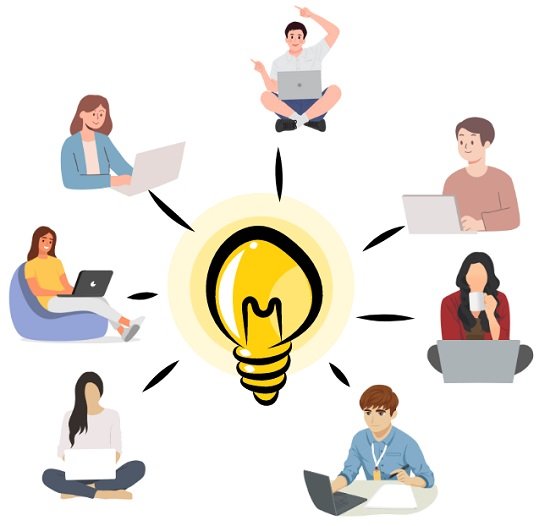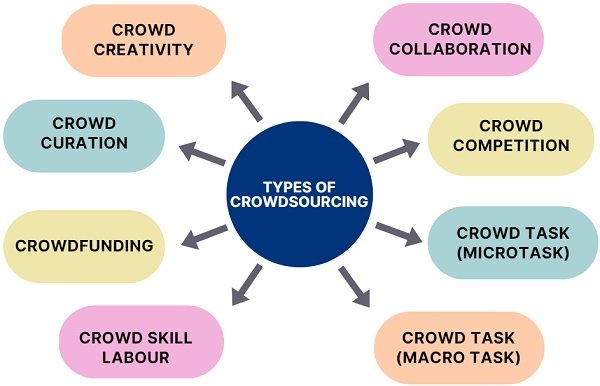Definition: Crowdsourcing is a way to get ideas from a large pool of people. It encompasses putting forward a question or problem to a large group of people with the aim of getting the best answer.
The word ‘Crowdsourcing’ is created by joining two words, ‘crowd’ and ‘outsourcing’. In this, the firm or individual outsources work to a large unknown crowd of people. So, they seek knowledge, goods and services, ideas, votes, finances etc., from a large pool of participants. The services could be free of cost or paid.
What is Crowd?
A ‘crowd’ in crowdsourcing refers to a network of people that act in response to the open call for contribution to the given task.
Do you know?
The term was first used by Jeff Howe – author of ‘Wired‘ magazine in the year 2006, in his article ‘The Rise of Crowdsourcing‘. It is a model of using a virtual labour pool, easily available on demand, for performing tasks and projects.
Concept of Crowdsourcing
Crowdsourcing is a model that helps bring the dispersed knowledge and ideas of groups to produce vivid resources for the organization. To be precise, crowdsourcing is the process of collecting information, work, opinion or input concerning a task or project by signing up for the services or support of a people using a digital platform. That is to say; people provide data through the internet, social media, etc.
Crowdsourcing participants are the third party which is not related to the firm, looking for results. These participants provide the required output in response to the online request made using different sources.
As said earlier, crowdsourcing uses digital channels to find, attract and allocate work to the participants to get the result. In this, the firm or individual invites the public to:
- Perform a designing task,
- Develop new technology,
- Provide solutions,
- Analyze data
You should take note here that it is not a new concept. It has turned out as an effective source of ideas by using the internet and social networking.
In recent times, crowdsourcing has been the talk of the town. Business organizations use this method to collect input from individuals. It involves using the collective wisdom and differential insights of the crowd by delegating the work among the group and using technology and modern means of communication to document and share the outcome.
Characteristics of Crowdsourcing
- The workers receive their money on the basis of results rather than the hours worked. Hence, speed of delivery and effectiveness plays a very important role.
- There is zero expenditure on marketing or sales.
- The worker is dispersed so that they can be multi-location and specialised in the concerned field.
- It is a competitive place for skills, knowledge, talent and ideas.
Example
A classic example of crowdsourcing is online reviews. Have you ever reviewed a hospital or a hotel on Google? If yes, then you, too, are a part of crowdsourcing.
Advantages
- It increases cost-effectiveness, which leads to an increase in profitability.
- They offer a new perspective on the issues that the team has struggled with for ages.
- It provides a platform for people to show their talents and creative approach.
Limitations
- There is very limited control over the output, and it may or may not be upto the required standards.
- No scope for confidentiality. This is because everything is on the internet, and the task can be accessed by any person.
- There is always a risk of plagiarism, as some people would make an attempt to copy someone else’s work.
Crowdsourcing Models/Types
- Crowd Collaboration: Large community of people offer collective knowledge or innovative ideas to an organization for solving a problem. For Example, 99Designs, Quirky, etc.
- Crowd Competition: For developing actionable solutions and models. For Example, Kaggle, TopCoder, etc.
- Crowd Task (microtask): Clearly defined, routine tasks for individuals that need general skills only, such as data-entry work or document formatting. For Example, Amazon’s Mechanical Turk, TaskRabbit etc.
- Crowd Task (macro task): Vaguely defined or poorly structured tasks or problems that require specialist skills or judgement like consulting or research. For Example, Applause, Fiverr.com, Upwork.com, Freelancer.com
- Crowd skill labour: To perform physical tasks like carpenter, makeup artist, photography, plumbing, etc. For Example, Urban Company
- Crowdfunding: To raise funds for a person or organization (startups) for an innovative product service or collect donations for someone suffering from a severe disease. For Example, Kickstarter.com or Ketto.org
- Crowd Curation: It is for developing and sharing knowledge with people. For Example, Wikipedia, TripAdvisor
- Crowd Creativity: It is when a large group of people share their innovative and creative ideas with people by creating content. For Example YouTube
A word from Business Jargons
At present, almost all sectors, from education to entertainment, is using crowdsourcing. It is the practice of taking an activity which is performed by a specialised agent in general and is outsourced to a large group by making an open call.



Leave a Reply